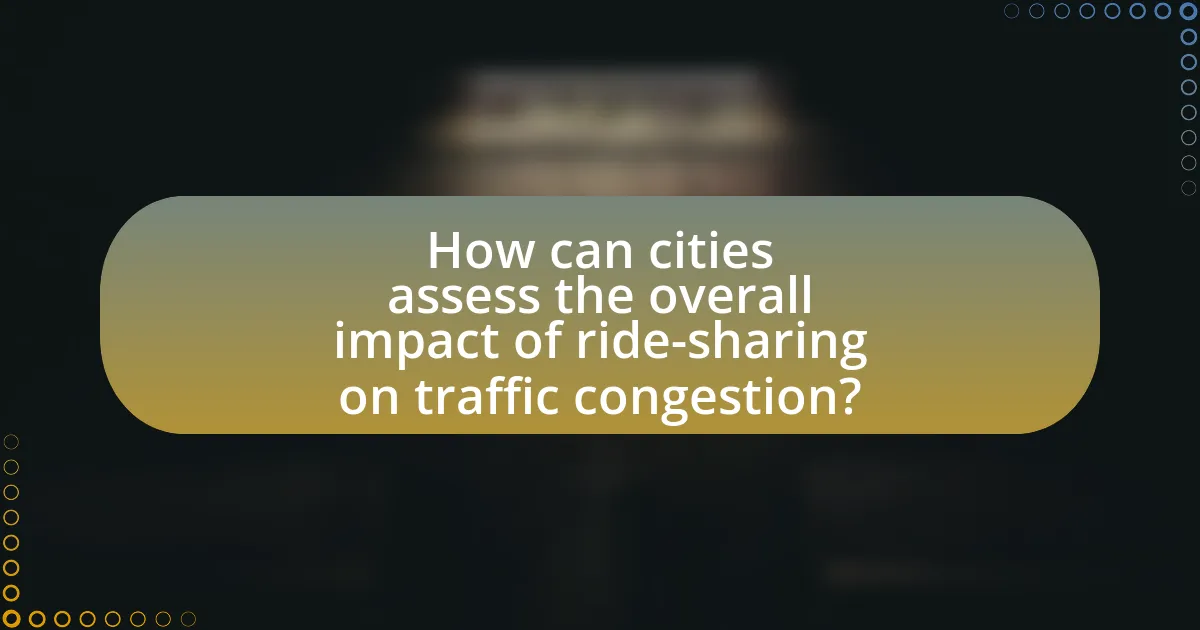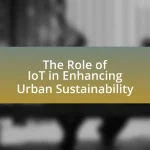The article examines the impact of ride-sharing services on urban traffic congestion, highlighting both the increase in vehicle miles traveled (VMT) and the potential for reduced congestion through carpooling. It discusses key factors influencing ride-sharing usage, such as convenience and cost, and compares the traffic effects of ride-sharing with traditional taxi services. The article also addresses the challenges ride-sharing poses to urban traffic management, including regulatory issues and emergency response times, while outlining strategies for cities to optimize ride-sharing benefits and mitigate negative impacts on traffic flow. Additionally, it emphasizes the role of technology and data analytics in enhancing ride-sharing efficiency and understanding its effects on urban congestion.

What is the impact of ride-sharing on urban traffic congestion?
Ride-sharing generally increases urban traffic congestion. Studies indicate that ride-sharing services contribute to a rise in vehicle miles traveled (VMT), as users often opt for these services instead of public transportation or walking. For instance, a study by the University of California, Berkeley, found that ride-hailing services like Uber and Lyft increased congestion by 2-3% in major cities, as these services often lead to more cars on the road, including those circling to pick up passengers. Additionally, the presence of ride-sharing vehicles can exacerbate traffic delays, particularly during peak hours, as they frequently stop to pick up and drop off passengers.
How does ride-sharing contribute to changes in traffic patterns?
Ride-sharing contributes to changes in traffic patterns by reducing the number of single-occupancy vehicles on the road, which can lead to decreased congestion. Studies indicate that ride-sharing services can decrease vehicle miles traveled (VMT) by up to 10% in urban areas, as they encourage carpooling and provide an alternative to personal vehicle use. Additionally, a report from the University of California, Berkeley, found that ride-sharing can lead to increased traffic in some areas due to the need for drivers to reposition themselves between rides, but overall, it tends to optimize vehicle usage and reduce the total number of cars needed for transportation.
What are the key factors influencing ride-sharing usage in urban areas?
Key factors influencing ride-sharing usage in urban areas include convenience, cost, availability of services, and urban infrastructure. Convenience is driven by the ease of accessing ride-sharing apps and the speed of service, which appeals to users seeking quick transportation options. Cost-effectiveness is significant, as many users prefer ride-sharing over traditional taxis due to lower fares; for instance, a study by the University of California, Berkeley, found that ride-sharing can be 30% cheaper than taxi services. The availability of ride-sharing services, particularly in densely populated areas, enhances user adoption, with cities like San Francisco reporting high usage rates due to the presence of multiple providers. Lastly, urban infrastructure, such as traffic conditions and parking availability, directly impacts ride-sharing efficiency and user satisfaction, as noted in research published by the Transportation Research Board, which highlights that well-designed urban environments facilitate higher ride-sharing usage.
How do ride-sharing services compare to traditional taxi services in terms of traffic impact?
Ride-sharing services generally contribute to lower traffic congestion compared to traditional taxi services. Research indicates that ride-sharing can reduce the number of vehicles on the road by promoting carpooling and optimizing routes, which decreases overall traffic volume. A study by the University of California, Berkeley, found that ride-sharing services like Uber and Lyft can reduce vehicle miles traveled by up to 10% in urban areas, as they often replace single-occupancy trips. In contrast, traditional taxi services typically operate independently, leading to higher vehicle counts and increased congestion.
What are the potential benefits of ride-sharing for urban traffic congestion?
Ride-sharing can significantly reduce urban traffic congestion by decreasing the number of vehicles on the road. Studies indicate that ride-sharing services can lead to a reduction in personal car trips, with estimates suggesting that for every shared ride, up to 3.5 personal vehicle trips are eliminated. This reduction in vehicle volume can alleviate traffic bottlenecks, lower travel times, and decrease emissions. Additionally, ride-sharing promotes more efficient use of existing road infrastructure, as fewer cars lead to less congestion and improved overall traffic flow.
How can ride-sharing reduce the number of vehicles on the road?
Ride-sharing can reduce the number of vehicles on the road by allowing multiple passengers to share a single vehicle for their journeys. This practice decreases the overall demand for individual car ownership and usage, leading to fewer cars on the streets. For instance, a study by the University of California, Berkeley, found that ride-sharing services can replace up to 10 personal vehicles for every shared ride, significantly lowering traffic congestion and emissions in urban areas.
What role does ride-sharing play in promoting public transportation usage?
Ride-sharing significantly promotes public transportation usage by providing first-mile and last-mile connectivity, which enhances access to transit services. Studies indicate that individuals who use ride-sharing services are more likely to utilize public transportation for longer trips, as ride-sharing can bridge the gap between home or work and transit stations. For instance, a report from the University of California, Berkeley, found that 30% of ride-sharing users reported using public transit more frequently due to the convenience of ride-sharing options. This synergy between ride-sharing and public transit can lead to reduced reliance on personal vehicles, ultimately alleviating urban traffic congestion.

What challenges does ride-sharing pose to urban traffic management?
Ride-sharing poses significant challenges to urban traffic management by increasing congestion and complicating regulatory frameworks. The influx of ride-sharing vehicles contributes to higher traffic volumes, as these vehicles often circle neighborhoods while waiting for passengers, leading to increased delays and reduced road efficiency. A study by the University of California, Berkeley, found that ride-hailing services increased traffic congestion in San Francisco by 63% between 2010 and 2016, highlighting the direct impact on urban traffic dynamics. Additionally, the lack of standardized regulations for ride-sharing companies complicates enforcement and coordination with existing public transportation systems, further straining urban traffic management efforts.
How does ride-sharing contribute to increased traffic congestion in certain scenarios?
Ride-sharing contributes to increased traffic congestion in certain scenarios by increasing the number of vehicles on the road, particularly during peak hours. When individuals opt for ride-sharing instead of public transportation or walking, it can lead to more cars circulating in urban areas, often searching for passengers or parking. A study by the University of California, Berkeley, found that ride-hailing services like Uber and Lyft accounted for a significant rise in vehicle miles traveled (VMT), with estimates suggesting that these services increased VMT by 2.5 times in some cities. This additional traffic can exacerbate congestion, especially in densely populated areas where road capacity is limited.
What are the implications of ride-sharing on parking demand in urban areas?
Ride-sharing significantly reduces parking demand in urban areas by decreasing the number of vehicles needing parking spaces. Studies indicate that ride-sharing services can lead to a 10-20% reduction in parking demand, as users opt for these services instead of driving their own cars. This shift can alleviate congestion and free up valuable urban space, allowing for potential repurposing of parking areas for other uses, such as green spaces or commercial developments. Additionally, research from the University of California, Berkeley, found that ride-sharing can lead to a decrease in the need for parking infrastructure, as fewer parking spaces are required when more people share rides rather than using individual vehicles.
How do ride-sharing services affect emergency response times in congested areas?
Ride-sharing services negatively affect emergency response times in congested areas by increasing traffic density and reducing road availability for emergency vehicles. Studies indicate that the presence of ride-sharing vehicles contributes to higher congestion levels, which can delay emergency responders. For instance, research published in the journal “Transportation Research Part A” found that ride-sharing services can increase overall vehicle miles traveled in urban environments, leading to longer response times for emergency services. Specifically, a 2019 study by the University of California, Berkeley, highlighted that emergency response times in San Francisco increased by an average of 10% during peak ride-sharing activity periods. This evidence demonstrates that ride-sharing services can hinder the efficiency of emergency response in congested urban settings.
What regulatory challenges do cities face with ride-sharing services?
Cities face significant regulatory challenges with ride-sharing services, primarily related to safety, insurance, and local transportation laws. These challenges arise because ride-sharing companies often operate in a legal gray area, lacking clear regulations that govern traditional taxi services. For instance, cities must ensure that ride-sharing drivers meet safety standards, which can include background checks and vehicle inspections, similar to those required for taxis. Additionally, cities grapple with the need to regulate insurance coverage for ride-sharing drivers, as many policies may not adequately protect passengers or drivers during ride-sharing activities. Furthermore, local governments often struggle to integrate ride-sharing services into existing public transportation frameworks, which can lead to increased traffic congestion and competition with traditional taxi services. According to a 2020 study by the National Academies of Sciences, Engineering, and Medicine, cities that fail to establish clear regulations for ride-sharing can experience a 2-3% increase in traffic congestion due to the rise in vehicle miles traveled by these services.
How can cities effectively regulate ride-sharing to mitigate congestion issues?
Cities can effectively regulate ride-sharing to mitigate congestion issues by implementing measures such as dynamic pricing, designated pick-up and drop-off zones, and limiting the number of ride-sharing vehicles on the road. Dynamic pricing adjusts fares based on demand, encouraging users to travel during off-peak hours, which can reduce congestion during peak times. Designated zones streamline the flow of traffic by minimizing double parking and ensuring that ride-sharing vehicles do not obstruct lanes. Additionally, capping the number of ride-sharing vehicles can prevent oversaturation in busy areas, as evidenced by studies showing that cities with such regulations experience lower congestion levels. For instance, San Francisco’s regulations have led to a decrease in ride-sharing vehicle miles traveled, demonstrating the effectiveness of these strategies in managing urban traffic congestion.
What are the best practices for integrating ride-sharing into existing urban transport systems?
The best practices for integrating ride-sharing into existing urban transport systems include establishing regulatory frameworks, promoting partnerships between ride-sharing companies and local governments, and enhancing data sharing for better traffic management. Regulatory frameworks ensure safety and compliance, while partnerships can facilitate the integration of ride-sharing services with public transport schedules and routes. Data sharing allows for real-time traffic analysis, enabling cities to optimize routes and reduce congestion. For instance, cities like San Francisco have implemented policies that require ride-sharing companies to share trip data, which has led to improved traffic flow and reduced congestion in key areas.

How can cities assess the overall impact of ride-sharing on traffic congestion?
Cities can assess the overall impact of ride-sharing on traffic congestion by analyzing traffic patterns, conducting surveys, and utilizing data analytics from ride-sharing platforms. Traffic pattern analysis involves comparing congestion levels before and after the introduction of ride-sharing services, using metrics such as average travel times and vehicle counts. Surveys can gather public perception and usage data, revealing how ride-sharing affects individual transportation choices. Additionally, data analytics from ride-sharing companies can provide insights into trip frequency, duration, and routes taken, allowing cities to quantify the contribution of ride-sharing to overall traffic flow. Studies, such as those conducted by the University of California, Berkeley, have shown that ride-sharing can both alleviate and exacerbate congestion, depending on factors like vehicle occupancy rates and the availability of public transit options.
What metrics should be used to evaluate the effectiveness of ride-sharing in reducing congestion?
To evaluate the effectiveness of ride-sharing in reducing congestion, key metrics include vehicle miles traveled (VMT), average occupancy rates, and changes in traffic flow. Vehicle miles traveled measures the total distance driven by all vehicles, indicating how ride-sharing impacts overall travel demand. Average occupancy rates reflect the number of passengers per vehicle, which helps assess how efficiently ride-sharing utilizes road space. Changes in traffic flow can be analyzed through metrics such as average speed and travel time on congested routes, providing insight into how ride-sharing affects congestion levels during peak hours. These metrics collectively offer a comprehensive view of ride-sharing’s impact on urban traffic congestion.
How can data analytics enhance understanding of ride-sharing’s impact on traffic flow?
Data analytics can enhance understanding of ride-sharing’s impact on traffic flow by providing insights into patterns of ride-sharing usage, trip origins and destinations, and peak demand times. By analyzing large datasets from ride-sharing platforms, researchers can identify correlations between ride-sharing activity and traffic congestion levels, revealing how ride-sharing contributes to or alleviates traffic issues. For instance, a study by the University of California, Berkeley, found that ride-sharing services increased vehicle miles traveled in urban areas by 2.5 to 3.5 times, indicating a significant impact on traffic flow. This data-driven approach allows urban planners to make informed decisions regarding infrastructure improvements and traffic management strategies.
What case studies provide insights into the relationship between ride-sharing and urban congestion?
Case studies from cities like San Francisco, New York City, and Seattle provide insights into the relationship between ride-sharing and urban congestion. In San Francisco, a study by the Transportation Sustainability Research Center found that ride-sharing services contributed to a 60% increase in vehicle miles traveled, exacerbating congestion. New York City’s analysis indicated that ride-sharing vehicles accounted for 40% of traffic congestion during peak hours, as reported by the NYC Taxi and Limousine Commission. In Seattle, research from the University of Washington revealed that ride-sharing services increased overall traffic by 15%, highlighting the impact on urban congestion. These case studies collectively demonstrate that ride-sharing can significantly influence traffic patterns and congestion levels in urban areas.
What strategies can urban planners implement to optimize ride-sharing benefits?
Urban planners can optimize ride-sharing benefits by integrating dedicated pick-up and drop-off zones, enhancing public transit connectivity, and implementing dynamic pricing strategies. Dedicated zones reduce congestion by streamlining the flow of ride-sharing vehicles, while improved public transit connections encourage users to combine services, thereby decreasing the number of single-occupancy vehicles on the road. Dynamic pricing can manage demand during peak times, ensuring that ride-sharing remains a viable alternative to personal vehicle use. Studies show that cities with well-defined ride-sharing infrastructure experience up to a 20% reduction in traffic congestion, highlighting the effectiveness of these strategies.
How can cities encourage ride-sharing while minimizing negative traffic impacts?
Cities can encourage ride-sharing while minimizing negative traffic impacts by implementing dedicated ride-sharing lanes and providing incentives for users. Dedicated lanes facilitate smoother traffic flow for ride-sharing vehicles, reducing congestion caused by frequent stops. Incentives, such as reduced parking fees or access to high-occupancy vehicle lanes, encourage more individuals to opt for ride-sharing instead of single-occupancy vehicles. Studies show that cities with such measures have seen a decrease in overall traffic congestion; for example, San Francisco’s implementation of ride-sharing lanes led to a reported 10% reduction in traffic delays.
What role does technology play in improving ride-sharing efficiency in urban settings?
Technology significantly enhances ride-sharing efficiency in urban settings by optimizing routing, reducing wait times, and improving vehicle utilization. Advanced algorithms analyze real-time traffic data and user demand to create efficient routes, which minimizes travel time and fuel consumption. For instance, a study by the University of California, Berkeley, found that ride-sharing services can reduce vehicle miles traveled by up to 40% in congested areas through effective dispatching and ride-matching technologies. Additionally, mobile applications facilitate seamless communication between drivers and passengers, further streamlining the process and increasing overall satisfaction.
What are the best practices for individuals to utilize ride-sharing effectively in urban areas?
To utilize ride-sharing effectively in urban areas, individuals should plan their trips during off-peak hours to avoid congestion, as traffic patterns can significantly impact travel times. Additionally, using ride-sharing apps that provide real-time data on traffic conditions can help users select the most efficient routes. According to a study by the University of California, Berkeley, ride-sharing can reduce the number of vehicles on the road by up to 20% during peak hours when utilized effectively. Furthermore, individuals should consider carpooling options within ride-sharing services to maximize vehicle occupancy, which can further alleviate urban traffic congestion.


